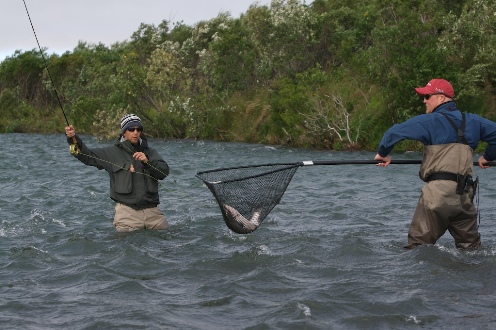This blog post comes to us from Fish Alaska contributing editor and Pacific Northwest salmon and steelhead guide JD Richey, who can be reached through his website.
Without exception, when the weather is at its absolute snottiest, I’ll get a call from my pop, who is a self proclaimed “Indoor Enthusiast,” that starts something like this:
“There’s no way you are fishing out there today in this weather…” And, as always, I remind him that it’s my job and that I’m usually perfectly warm and dry because of my clothing choices.
“Dad, we’re not wearing long johns quilted fleece anymore.”
The technological advancements in the world of textiles just in my fishing career have been immense. Now, there’s gear for every situation imaginable that’s designed to shed water, block wind, breathe, stretch and generally make you feel comfortable when the weather’s inhospitable. In fact, there’s so much stuff out there these days that it gets overwhelming. So, with that in mind, I’m going to play the role of a “foul-weather Ralph Lauren” and suggest some outfits that enable you get to get out and catch some fish this season…regardless of the elements.
BASE LAYER
The foundation of core warmth is the base layer. To avoid confusion, think about an updated version of the old checkered long underwear we used to don…only the new stuff is lighter, warmer, thinner, more comfortable and wicks moisture. It’s an upgrade all right…akin to the fishing rods of today compared to models from the 1950s.
Many companies make base layers (check out Carhartt’s Work-Dry bottoms and long-sleeve crews or Grundens’ Fiske Skins pants and crew neck tops) and they typically come in light, medium and heavy weights. You’ll have to decide which is best for you, depending on the weather and your planned activity level.
MIDDLE LAYER

A modern fleece of some sort fits the bill nicely here. They keep you warm and are generally breathable. I prefer ones that are windproof, especially if there’s a possibility it may get warm enough to strip off my outer layers.
The Heat 360 II fleece pullover by Columbia is pretty slick because it has a thermal reflective lining to retain the natural warmth of your body. The StormKloth II Hunting Vest is another good choice.
Now, as I alluded to a bit earlier, your middle layer sometimes becomes your outer layer—perhaps the day warms up and you shed your warm coat or it’s not a continuous downpour anymore and the foul-weather gear comes off. In that case, it’s important to select a mid-layer that also will have you covered.
Soft-shell jackets are a favorite of mine in this department – comfortable, light and able to repel modest rain and wind. A fine example of that is Drift Creek Outdoors’ Stormbloc Insulated Soft Shell Hoodie. It’s wind- and waterproof, breathable and stretches four ways. It also has a micro-fleece liner, so it really is comfortable and protects you from an unexpected drizzle or gust.
Because of the new layering systems, you typically don’t need a big, bulky outer layer like we had to wear in the past. The modern stuff is made from a wide variety of lightweight materials and there are options for everyone from the commercial fisherman down to the casual angler. Which style you choose should be based on what sort of activity (and how much of it) you plan on doing—and prevailing weather conditions.
OUTER LAYER
When I’m guiding on the rivers and the weather is at its worst, I completely cover up with tough-as-nails PVC bibs and hoodies from Grundens. Their stuff is absolutely bulletproof (there’s a reason all those Bering Sea crabbers wear their gear). Another impressive choice is the Strykr jacket & bibs from STORMR, which feature unique Neoprene Core Technology. The result is outerwear that is waterproof, windproof and also has positive buoyancy.
Fully waterproof and breathable outer layers are also a great way to go—especially if the weather’s a little warmer and/or you will be exerting yourself. I tend to go this route when hiking into fishing spots or when I’m rowing the drift boat or raft. It can rain all it wants and I stay dry…and due to the breathability factor, I can sweat inside the garments and not get clammy.
Grunden’s Gage Technical Gear Line fits the bill perfectly. Their Storm Surge 2.5-layer jacket and pants provide durable protection from just about anything Mother Nature can dish, while also maintaining superior breathability. Basically, you’re getting the same quality the company’s famous for with its commercial gear—in a style and material that’s more suited to those of us who don’t fish in the dead of winter on the Bering Sea. Drift Creek Outdoors’ Tundra Tech raingear is also worthy of note.
When it comes to lightweight, packable rain gear—stuff that’s easy to store and carry, you can’t go wrong with the classic Frogg Toggs. Made out of some cool space-age material that feels almost as light as paper, I’ve used them on warm, rainy days a lot and also when I need to stay dry but am doing a lot of physical activity like hiking or mountain biking into a favorite fishing spot.
There are also days when the weather is clear and cold and the insulating properties of your outer layer are more important than water repellency. On the most frigid of days, consider wearing something like Carhartt’s Kalaska Down coats or bibs. I’m also a huge fan of the new style “faux down” coats that many companies sell like Marmot, Montbell, Mountain Hardwear, and Sierra Designs—insulated with synthetic materials instead of feathers. They are typically as warm as down but without the bulk and are really comfortable. Check out Columbia’s Shimmer Me Timbers II, which has their popular Omni Heat technology.
Now, get out there and enjoy the great outdoors this spring—in comfort!
